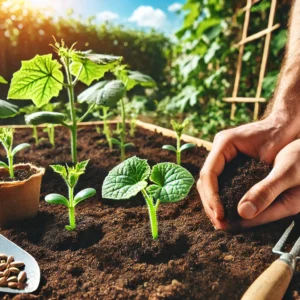1. What is the best time to plant mango trees?
The best time to plant mango trees is during the late spring to early summer, which allows the tree to establish itself before the onset of colder weather.
2. How much sunlight does a mango tree need?
Mango trees need full sunlight, which means they require at least 6-8 hours of direct sunlight daily for optimal growth and fruit production.
3. What type of soil is best for growing mango trees?
Mango trees prefer well-draining, sandy loam soil with a slightly acidic to neutral pH (around 5.5 to 7.5).
4. How often should mango trees be watered?
Mango trees should be watered deeply but infrequently, allowing the soil to dry out between waterings. Young trees may need watering once or twice a week, while mature trees require watering every 1-2 weeks.
5. What is the ideal spacing for planting mango trees?
Mango trees should be spaced about 25-30 feet apart to allow for proper growth and air circulation.
6. How can I improve soil drainage for mango trees?
Improving soil drainage can be done by mixing in organic matter such as compost, creating raised beds, or adding sand to heavy clay soils.
7. When should I fertilize my mango tree?
Fertilize mango trees during the growing season, typically in spring and summer. Use a balanced fertilizer or one specifically formulated for fruit trees.
8. What pests commonly affect mango trees?
Common pests include mango scales, mealybugs, aphids, and fruit flies. Regular inspection and appropriate treatments are necessary to manage these pests.
9. How can I prevent mango tree diseases?
Prevent diseases by practicing good sanitation, avoiding over-watering, ensuring proper spacing for air circulation, and using disease-resistant varieties.
10. How do I prune a mango tree?
Prune mango trees to maintain shape, remove dead or diseased branches, and improve sunlight penetration. Pruning is best done after the harvest or during the dormant season.
11. How long does it take for a mango tree to bear fruit?
Grafted mango trees typically bear fruit in 3-4 years, while trees grown from seed can take 5-8 years or longer.
12. What is the best way to propagate mango trees?
Mango trees are best propagated through grafting to ensure the new tree inherits the desirable traits of the parent plant.
13. Can mango trees be grown in containers?
Yes, dwarf varieties of mango trees can be grown in large containers, provided they receive adequate sunlight and care.
14. How do I protect mango trees from frost?
Protect mango trees from frost by covering them with blankets or burlap, using frost cloth, or installing frost protection devices such as heaters or wind machines.
15. What are the signs of overwatering in mango trees?
Signs of overwatering include yellowing leaves, root rot, and poor growth. Ensure proper drainage and allow the soil to dry out between waterings.
16. How do I identify and treat mango anthracnose?
Anthracnose is identified by black spots on leaves, flowers, and fruits. Treat by removing affected parts and applying fungicides.
17. What varieties of mango trees are best for home gardens?
Popular varieties for home gardens include ‘Haden,’ ‘Tommy Atkins,’ ‘Kent,’ ‘Keitt,’ and ‘Ataulfo.’
18. How can I encourage more fruit production on my mango tree?
Ensure proper fertilization, adequate watering, and regular pruning. Also, thinning out some fruits can help remaining fruits grow larger.
19. How do I deal with mango fruit flies?
Control fruit flies by using traps, bagging young fruits, and applying appropriate insecticides if necessary.
20. Can mango trees grow in cold climates?
Mango trees are tropical and subtropical and do not tolerate frost. They are best suited for USDA zones 10-11.
21. What are the benefits of mulching mango trees?
Mulching helps retain soil moisture, suppresses weeds, and provides organic matter as it decomposes.
22. How can I tell if my mango tree is healthy?
A healthy mango tree has vibrant green leaves, strong growth, and produces flowers and fruit in season.
23. Why are my mango tree leaves turning yellow?
Yellow leaves can indicate overwatering, nutrient deficiencies, or pest infestations. Evaluate watering practices and check for pests and diseases.
24. How do I prevent mango tree root rot?
Prevent root rot by ensuring proper soil drainage, avoiding overwatering, and using well-draining soil.
25. What should I do if my mango tree is not flowering?
Ensure the tree is getting enough sunlight, water, and nutrients. Pruning and proper care can also encourage flowering.
26. How do I transplant a mango tree?
Transplant mango trees during the dormant season, ensuring minimal root disturbance and planting at the same depth as in the previous location.
27. Can mango trees be grown indoors?
While challenging, dwarf varieties can be grown indoors with sufficient light, humidity, and space.
28. What is the best method for harvesting mangoes?
Harvest mangoes when they are mature but still firm. Twist or cut the fruit from the tree, leaving a small stem attached.
29. How can I store harvested mangoes?
Store ripe mangoes in the refrigerator for up to a week. Unripe mangoes can be kept at room temperature until they ripen.
30. What companion plants are beneficial for mango trees?
Companion plants like marigolds, garlic, and basil can help deter pests and improve soil health.
31. How do I deal with mango seed weevils?
Control seed weevils by destroying infested fruits, maintaining good orchard sanitation, and applying insecticides if necessary.
32. What is the lifespan of a mango tree?
Mango trees can live for over 100 years, with proper care and favorable conditions.
33. How do I graft a mango tree?
Grafting is done by joining a scion from a desired variety to a rootstock. Common methods include cleft grafting and veneer grafting.
34. What are the symptoms of mango bacterial black spot?
Symptoms include black spots on leaves, stems, and fruit. Control with copper-based fungicides and by removing infected plant parts.
35. How can I improve fruit set on my mango tree?
Improving fruit set involves proper pollination, balanced fertilization, and good watering practices.
36. What role does pollination play in mango production?
Pollination is crucial for fruit set. Mangoes are primarily pollinated by insects, so maintaining a healthy insect population is important.
37. How do I deal with nutrient deficiencies in mango trees?
Address nutrient deficiencies by applying appropriate fertilizers and amendments based on soil and leaf analysis.
38. What type of fertilizer is best for mango trees?
Use a balanced fertilizer with a higher potassium content during the fruiting period. A typical NPK ratio of 8-3-9 is suitable.
39. Can mango trees be grown from cuttings?
Mango trees are not typically grown from cuttings, as this method has a low success rate. Grafting is preferred.
40. How do I protect mango trees from strong winds?
Protect mango trees from strong winds by planting windbreaks, staking young trees, and pruning to reduce wind resistance.
41. What are the benefits of using organic mulch for mango trees?
Organic mulch helps retain moisture, suppress weeds, improve soil structure, and provide nutrients as it decomposes.
42. How do I control fungal infections in mango trees?
Control fungal infections with proper sanitation, fungicide applications, and by ensuring good air circulation around the tree.
43. How do I perform a soil test for my mango tree?
Collect soil samples from the root zone and send them to a lab for analysis. Follow recommendations based on the results.
44. What is the best way to deal with mango tree suckers?
Remove suckers promptly by cutting them off at the base to prevent them from diverting energy from the main tree.
45. How do I prepare the planting hole for a mango tree?
Dig a hole twice the width and the same depth as the root ball. Amend the soil with organic matter if necessary.
46. Can I grow mango trees from store-bought mango seeds?
Yes, but trees grown from store-bought seeds may not produce fruit identical to the parent and will take longer to bear fruit.
47. What is mango malformation and how do I treat it?
Mango malformation is a disease caused by a fungus, resulting in deformed flowers and shoots. Remove and destroy affected parts and apply fungicides.
48. How can I enhance the flavor of my mangoes?
Enhance flavor by ensuring the tree receives adequate nutrients, especially potassium, and by harvesting at the right maturity stage.
49. How do I manage weeds around mango trees?
Manage weeds with mulch, manual weeding, or appropriate herbicides, being careful not to damage the tree’s roots.
50. What are some common mistakes to avoid when growing mango trees?
Common mistakes include overwatering, improper fertilization, neglecting pest control, and not providing enough sunlight. Proper care and attention to these factors are crucial for successful mango gardening.



